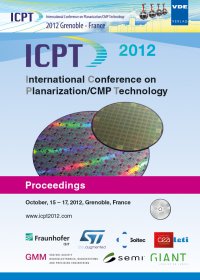Improvements in Profile Control using ISPC™ System During the Stop-in- Oxide CMP Step in the RMG Process Flow on IBM 20nm Short-Loop Wafers
Konferenz: ICPT 2012 - International Conference on Planarization / CMP Technology
15.10.2012-17.10.2012 in Grenoble, France
Tagungsband: ICPT 2012
Seiten: 6Sprache: EnglischTyp: PDF
Persönliche VDE-Mitglieder erhalten auf diesen Artikel 10% Rabatt
Autoren:
Komarenko, P.; Salfelder, J.; Economikos, L. (Applied Materials, 2531 Route 52, Suite 5, Hopewell Junction, NY 12533, USA)
Qian, J. (CMP Division, Silicon Systems Group, Applied Materials, 974 E. Arques Ave., Sunnyvale, CA 94085, USA)
Levedakis, D. (IBM Systems and Technology Group, IBM Semiconductor Research and Development Center (SRDC), 2070 Rt. 52, Hopewell Junction, NY 12533, USA)
Inhalt:
Improved profile control during CMP is becoming an increasingly important enabler for several key CMP steps in the Replacement Metal Gate (RMG) process for 20nm and beyond. Gate height control and final wafer yield can be directly or indirectly affected by CMP consistency and wafer center-to-edge profile control. In this study we focused on improvements to the stop-in-oxide bulk polish in the RMG process on 20nm IBM Short- Loop wafers. The In Situ Profile Control (ISPC(TM)) system on the Applied Materials Reflexion (r) LK platform, along with Titan Contour(TM) multi-zone polishing head, were utilized to control the center-to-edge post active oxide profile. The ISPC(TM) system collects and analyzes a high resolution broad band optical signal from each polishing zone during each platen rotation to measure in situ film thickness and make the appropriate pressure changes to correct for profile drift. Profile stability over pad life was demonstrated for wafers run at the beginning, middle and end of pad life where the wafers were open-loop (fixed pressure) or closed-loop (ISPC-controlled pressure). The ISPC system was used to control polishing time (endpoint) for both the open-loop and closed-loop wafers so that both sets of wafer had the same post-polish target thickness. The ISPC-controlled wafers consistently exhibited a much flatter profile following Active Oxide polish compared to the POR open-loop wafers, based on all-die F5 metrology. Zone-to-zone range was improved by more than 300% over pad life for closed-loop wafers (ISPC-control) vs open-loop POR wafers. Zone-to-zone range is defined as the maximum difference in average post-thickness of the control zones. The majority of the improvement from ISPC-control was due to the outer edge zones beyond 130mm radius. Since the edge zones are difficult to control in a production environment, the ISPC(TM) system provided a welcome improvement to RMG CMP process. Keywords: Planarization, Chemical Mechanical Polishing, In Situ Profile Control, ISPC(TM) System, Multi-zone Polishing Head, Advanced Process Control, Metal Gate


